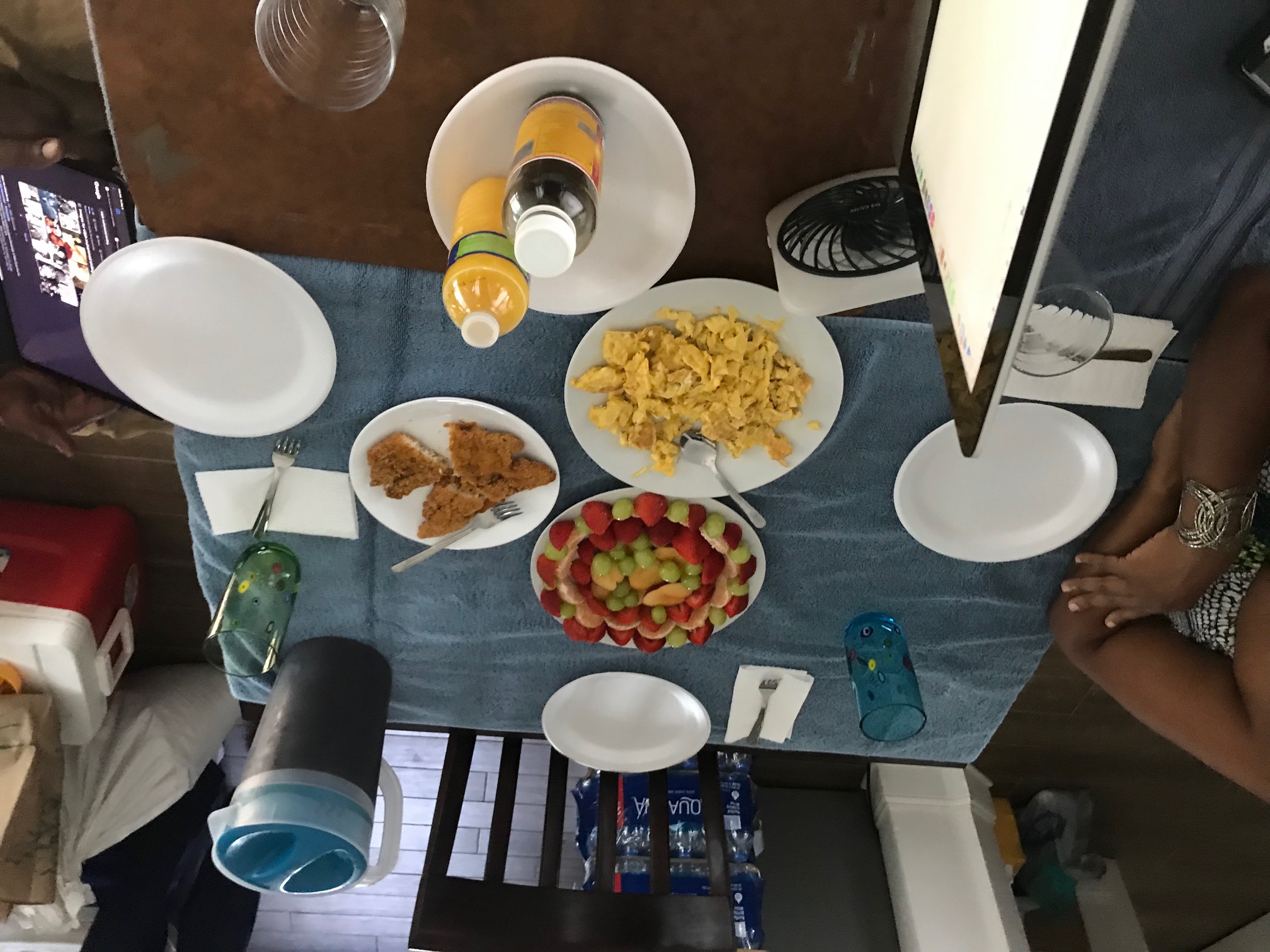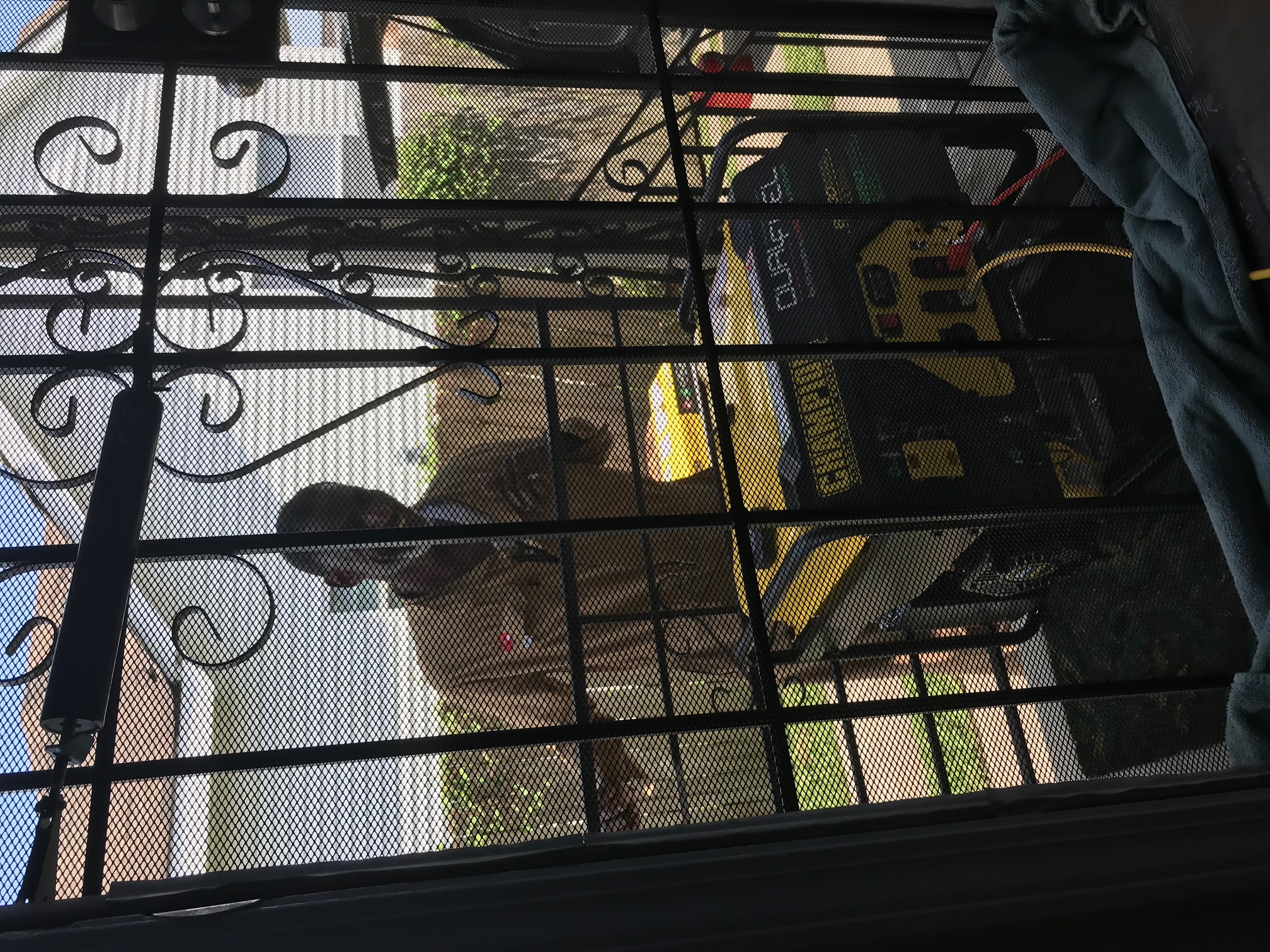

That’s a fruit plate, two small pieces of catfish cut in half, scrambled eggs, and two bottles of liquid nutritional supplements along with a big helping of tea to drink.
NEW ORLEANS–Another day trying to make it to the other side. . . started to paraphrase “the sunny side of the street” but sunshine is not what we need at this moment, even though blue skies and no rain is deeply appreciated.
This morning we woke up–I say woke up, but don’t get the impression we were sleeping in our own beds, especially not the beds we slept in last week. No. Many of us were making do on air mattresses, couches in other people’s homes, and shuffling about scavenging whatever provisions we could stumble across.
Of course, a number of us are still in our own abodes–however the bulk of many of my friends and associates have de-camped for other parts of the country–both near and far, known, and in quite a few cases, parts unknown.
I live in an apartment at Ashe Cultural Arts Center and decided to join my daughter, Asante, and Peteh Muhammad, Asante’s fiancé, along with Peteh’s son, Akeel. Asante lives on Norman Francis Blvd., the former Jefferson Davis Blvd., in what is called the mid-city area. When Ida hit we (including two dogs: “Eight” and “Chop”) moved to a house owned by Peteh’s people. He had agreed to take care of the property located in the 8th ward on Law Street, corner of Almonaster.
I write to you now from exile, even though I am ensconced in my native city.
Ida is a prelude to tomorrow. An opening act of America’s future. This is what next year, and the year after, so forth and so on, will look like. Dystopian and totally unpredicted events, increasingly, will dominate our days.
The follow-up of Ida oxymoronically did more damage in New York and New Jersey than it did in Louisiana where the storm crashed ashore. By Saturday, September 4th, over forty people have died as a result of the storm with only 4 reported fatalities in Louisiana.
Let me see if I can break down the disparity–particularly what happened in New Orleans.
New Orleans has a centuries long tradition of dealing with hurricanes. Today most Americans remember when Katrina hit the Crescent City. However, recalled or forgotten, history is not the problem. Tomorrow is the question.
Is our nation ready to really deal with climate change?
The tail-end of Ida, which crept quickly upon us, smacked Louisiana dead up in our face. While New Orleans suffered a near total loss of electricity, our city didn’t bear the brunt of Hurricane Ida. There were literally bunches of Louisiana small towns, villages, and a few medium-sized cities that were inundated with water and severely damaged by wind. A handful suffered storm damage to 100% of their physical infrastructure.
Three days after the storm, our hurricane household set off in a search of a larger generator. The little machine that Peteh bought almost two years ago for an entirely different purpose was not ideal for pulling 24/7 house duty during hurricane Ida.
So, we journeyed down into St. Bernard parish, a suburb just below New Orleans. About fifty or so years ago when I was growing up, if you were Black and had good sense, you didn’t go down there at night, indeed, not at all if you could help it. That was arch segregationist, judge Leander Perez country. The truly wise among us didn’t shop or stop there.
As we rode down Leander Perez highway, on a clear and sunny day, images and uncomfortableness flooded me even though nobody we passed seemed to give us a second thought. The reality was that this was not the same place as when I grew up back in the fifties.
Like something you see on television, we had pulled into the Tractor Supply store. It was big and busy, row after row of agricultural products and equipment. Peteh was comfortable. His regular gig is landscaping and interfacing with regional farmers and academic-based agrarian personnel at Southern University in Baton Rouge. I was completely out of my element and appropriately silent as I followed instructions.
Peteh and the sales person discussed generators. We ended up purchasing a 5500-watt portable to replace the 2200-watt unit we were then working with. Barely 15 miles south of New Orleans, the tractor and feed store had electricity. Without even a hint of racial animosity, the store employees bantered with us as though this was a normal day. What a strange combination: casual Deep South comity contrasted with the impersonal urbanity of New Orleans.
 Peteh inspects the small Honda unit we were working off (above) and the larger new generator we now use.
Peteh inspects the small Honda unit we were working off (above) and the larger new generator we now use.
In New Orleans the 9th ward takes up almost a full third of the city. I was born and grew up across the canal in the Lower Ninth ward. Asante is also ninth-ward born and reared. Indeed, when we returned from our little trip, because the Claiborne Avenue bridge was up, we decided to jump over to St. Claude Ave. and went down Egania, which is the street we lived on for a year or two, a couple or three years after Asante was born. She remembered the house when I pointed to it.
It’s a bit disconcerting trying to deal with conflicting realities. On the one hand I have all my pre-Civil Rights memories. On the other, there is an immense gulf between urban New Orleans and agrarian St. Bernard parish. This is a time and space warp that sling-shots one back and forth. I could be an extra in a Hollywood futuristic flick except this is real 21st century life.
Back at the homestead after our foray out into the nether world, 15 year-old chef Akeel decides to take the lead on preparing our brunch. Notice that he put in a lot of time arranging the fruit he cut up. The meal not only tastes good, the spread is also visually attractive.
We best get ready to carry on when there is a breakdown in whatever is our daily routine. A small stash of cash (at least $500) will make a big difference in the days ahead. Make plans to get with some of your buddies and purchase a generator and also, more importantly, have at least one person in your crew that knows how to maintain a generator.
I know this all sounds extreme and doesn’t seem to make much sense but the future is almost here and, as the world whirls and reels from climate disaster to climate disaster, you won’t be able to count on urban infrastructures to work in ways we know of as normal today. In the next decade, a comfortable modern life without an accessible source of electrical power is not going to be prudent.
Of course, life won’t all break down instantly or just in one place, but it will help a whole lot to have people, places and spaces that can function in a disaster context. Make sure you have access to household and electronic communications equipment beyond cell phones. Small and portable fans, battery-operated lamps (make sure you have a more than adequate supply of batteries), and especially power-strips & extension cords will be very valuable. And don’t forget a portable AM/FM radio. Many of us already own portable computers, they will be necessary along with medical supplies, and at least a tote bag to carry toileting items.
Howsoever one deals with the future, let’s not go grim and down hearted. We need laughs, smiles and, yes, giggles as we push on through to the next level. Life ought not be a depressing task to do your duty. We are the descendants of the formally (and formerly) enslaved. Our people pushed pass being downtrodden and created a culture that influences the world.
We did it with Ragtime, with Blues, Jazz and Gospel, with Hip Hop, and who knows what’s coming next.) Our oral and aural traditions are resilient and powerful.
If we are truly who we are, we will keep on pushing.
